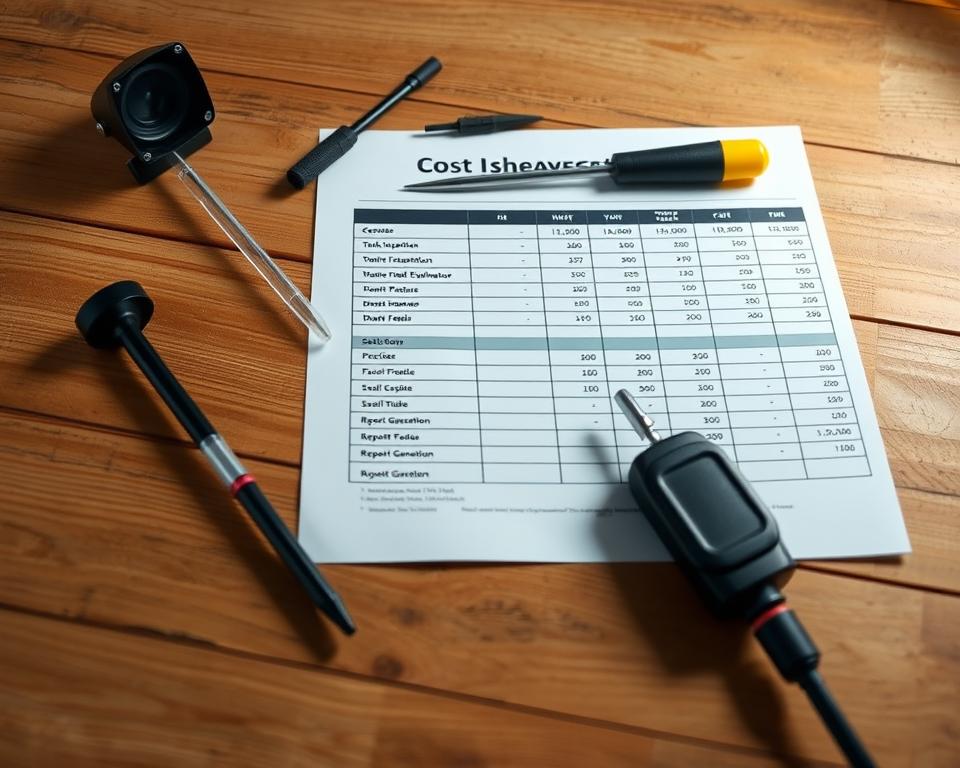Your Expense Guide for Septic Tank Pumping
Have you paused to consider about the true expense of up‑keeping your septic system current, or if you’re paying too much? It’s essential for homeowners to understand the specifics of septic tank pumping prices. Typically, the fee is roughly $420, yet it can range considerably. This spread results from elements like your tank’s volume and geographic area – septic pumping service.
Routine servicing of your septic tank avoids hefty remedies, underscoring the value of being aware of service costs. This article will dive into septic tank service pricing in depth. This will help you plan financially for your system’s maintenance.
Important Notes
- Average septic tank pumping runs about $420 USD.
- Prices can fall between $290 and $560 depending on various conditions.
- Regular servicing heads off pricier repairs later on.
- Most households need pumping every three to five years.
- Family size and water usage can affect pumping schedule.
Understanding the Value of Septic Tank Pumping
Septic tank pumping is essential for a efficient wastewater system. It extracts solids that, if ignored, create blockages. Regular pumping also avoids bad smells but also dodges hefty repair costs.
Overlooking septic tank maintenance can threaten our extensive reliance on these systems. Luckily, reasonably priced services reduce the risk of system failure. Regular upkeep prolongs your septic system’s life, helping maintain smooth operation.
Fee information for septic tank upkeep illustrates the value of preventive care. Regular service detects problems before they escalate, avoiding major damage and hefty repair bills. Routine pumping is a prudent move for homeowners to secure their investment and gain peace of mind.
Standard Fees for Septic Tank Pumping
Septic tank pumping typically ranges between $250 and $600 in cost. Most times, homeowners will spend about $400 for this essential service. Fee differences are driven by factors like tank size, where you live, and how often maintenance is done. Typical tanks, around 1,000 gallons, usually cost between $225 and $400.
Homeowners should realize the necessity of allocating funds every three to five years for septic tank pumping. This routine care is based on the system load and size. It helps avert bigger, costlier issues down the road, demonstrating to be both time and money‑efficient.

Factors Influencing Septic Tank Pumping Prices
Several variables are important in establishing the cost of septic tank pumping. Grasping these details enables homeowners to plan for these necessary services effectively.
The volume is significant a lot. Higher‑capacity tanks take more work and resources to empty, which translates into higher fees. The ease of access to your tank also significantly influences the price. Tanks set far underground or in hard‑to‑reach locations demand more time and special tools from technicians, thus raising the labor costs.
Costs can differ widely based on where you live. This is due to shifts in local labor rates and waste‑processing costs. For example, some areas impose higher charges for getting rid of waste, impacting the total service cost. Moreover, tanks with dense solid waste accumulation also see additional fees—anywhere from $100 to $300. Plus, the more frequently a tank requires pumping—due to higher household wastewater production—the higher the ongoing expenses.
Septic Tank Size and Its Effect on Cost
The volume of your septic tank strongly affects the cost of its upkeep. Lower‑capacity tanks, for example, those that can hold 750 gallons, tend to have lower pumping costs, usually ranging from $175 USD to $300. On the other hand, larger tanks, capable of holding up to 1,750 gallons, may incur charges between $400 and $700. The majority of single‑family residences have tanks that hold between one thousand to 1,250 gallons, providing a mix between capacity and function.
Households with smaller tanks or large households often require more frequent pumping services, which increases the overall expense. It’s vital to arrange regular septic tank inspections in these situations. This ensures the tank does not overflow or fail, which prevents additional damages. By understanding the relationship between tank size and service fees, homeowners can make smart choices regarding their septic systems and their upkeep needs.
Location‑Based Changes in Septic Tank Pumping Costs
Septic tank pumping costs can differ substantially based on area. In urban areas, the expenses are often higher due to local septic services having increased overhead. For example, Minneapolis, MN residents may spend between $180 USD and $280, while those in Portland, OR could see prices from $440 USD to $750.
The reasons behind these disparities are many. They include local living costs, demand for septic specialists, and regional regulations. In places where septic services are limited, homeowners might spend extra due to the service scarcity. Moreover, strict regulations in some regions can raise the need for higher compliance fees, influencing the cost of services.
Knowing about these geographic cost variances is important for homeowners. It allows them to plan their septic maintenance spending more accurately. By understanding local pricing, they can seek quotes from specialists prudently, maintaining their septic system efficiently without financial strain.
Extra Expenses to Consider with Septic Tank Pumping
Homeowners often overlook various additional maintenance costs associated with septic tank pumping. The core cost covers just the standard service, not covering other potential expenses. Being aware of these can aid in creating a comprehensive budget.
CCTV inspections, for instance, run between $250 USD to $500 USD. They offer a non‑invasive look into the system’s condition. Additionally, filter rinsing, which if overlooked can lead to system failures, represents another cost.
The spread for repairs can be broad, from $100 to $4,000, based on the specific issues. This spread underscores the need of factoring in additional maintenance costs for future budgeting.
Allocating Funds for Septic Tank Maintenance
When setting funds aside for septic tank upkeep, it’s critical to embrace a comprehensive view. This incorporates several critical elements. Due to variable factors, the cost of maintenance can shift considerably. Therefore, smart financial planning is indispensable.
To make sure your system functions efficiently and to dodge unforeseen bills, keep these timelines and services in mind:
- Regular pumping: This service is generally required every 3–5 years.
- Inspections: Plan for around $250 to $1,180 for inspections every three years.
- Potential repairs: Reserve a fund for unexpected fixes, which can occur unexpectedly.
Establishing a recurring maintenance calendar with a trusted septic service is key. By expecting these expenses, homeowners can sidestep the large costs tied to neglect. This strategy secures the durability and efficiency of their septic systems.
Early Warnings That Your Septic Tank Needs Pumping
Remaining vigilant to your septic system’s condition is vital. Identify the initial clues that suggest your septic tank requires pumping. Doing so can prevent major damage and reduce repair costs.
- Slow drains: Water taking longer to drain in sinks, tubs, or toilets could signal your septic tank is at capacity.
- Unpleasant odors: Bad smells coming from the septic tank or in your yard are frequently urgent signs of a problem.
- Gurgling sounds: Odd gurgling from your plumbing might suggest air is trapped because of a blockage.
- Wet spots: Standing water or greener grass sections near the drain field point to waste seepage from the tank.
- Dark green grass: Grass that is more vibrant and seems healthier around the drain field may show leakage of nutrients, signaling an issue.
Regular checks by septic system experts can maintain your tank is in healthy condition. Relying on experienced septic technicians for maintenance stops these issues, ensuring your system’s longevity.
Benefits of Routine Septic Tank Inspections
Frequent inspections are integral to keeping your septic system in excellent order. They spot potential problems before they turn into expensive repairs. By engaging professionals for these checks, every part of your system undergoes a thorough assessment.
The inspection looks at several parts of your system, including waste levels and the drain field’s status. It confirms that critical parts, like baffles, work as they should. Catching issues sooner helps prevent dangerous overflows and safeguards the environment, benefiting both your home and the wider community.
Having your septic tank evaluated every three years can cut a lot of money. It stops bigger issues from occurring due to neglect. This not only lowers on repair costs but also gives your peace of mind.
| Inspection Aspect | Importance |
|---|---|
| Waste Level Assessment | Prevents overflow and backups |
| Drain Field Evaluation | Identifies saturation and function |
| Component Functionality Check | Ensures proper system operation |
| Early Problem Detection | Saves on repair costs |
Tactics to Cut Costs on Septic Tank Pumping Prices
Homeowners looking to cut septic tank pumping costs have multiple strategic options. Arranging group services with neighbors is one smart method. This involves teaming up with others nearby to schedule services together, potentially securing group discounts. It’s a way to boost community bonds while managing expenses more effectively.
Another useful approach is to sign up for maintenance plans with septic service providers. These plans often offer reduced rates for scheduled check‑ups and pumpings, maintaining septic systems functioning properly at a lower cost. Homeowners are encouraged to ask about these plans when contacting service companies.
Making the septic tank accessible can also shave pumping expenses. Good accessibility means there’s less chance of extra labor charges. It’s wise to keep the area around the tank clear of clutter, permitting straightforward servicing.
Adopting certain habits helps in extending the time between pumpings as well. Lowering water usage and curbing garbage disposal use are key practices. These actions can significantly improve septic system health, decreasing the need for regular maintenance. By following these habits, homeowners can efficiently trim their septic tank pumping costs, preserving their budgets and systems.
In Closing
Making sure routine septic tank pumping is key for homeowners who want to keep their waste management system sound and effective. Understanding about the costs involved allows for accurate budgeting. This way, you can find cost‑effective septic services without sacrificing your system’s smooth operation.
Adopting a forward‑thinking approach to maintenance is extremely advantageous. By watching for clues that show the need for pumping, you can dodge expensive repairs and lengthen your system’s lifespan. Such actions not only improve your home’s functionality but also offer you peace of mind.
In conclusion, keeping up with routine inspections and timely septic tank pumping is essential for efficient home maintenance. By prioritizing proper planning and choosing affordable septic service, you’ll ensure your septic system remains operational and efficient for many years.


